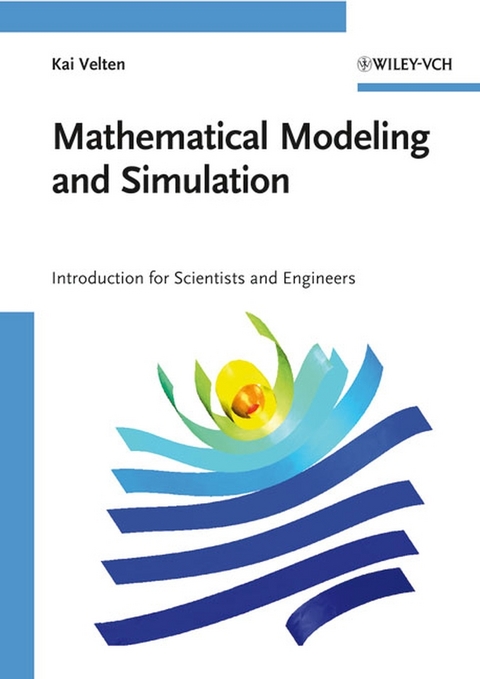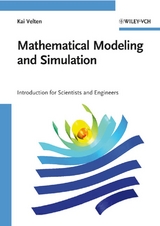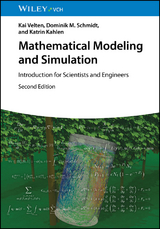Mathematical Modeling and Simulation
Wiley-VCH (Verlag)
978-3-527-40758-3 (ISBN)
- Titel gebraucht verfügbar
- Artikel merken
Um dieses Buch zu verstehen, müssen Sie lediglich Grundkenntnisse der Integral- und Differenzialrechnung und der linearen Algebra mitbringen. Der Autor erklärt auch für Einsteiger und Studenten unterer Semester verständlich, wie man einfache mathematische Modelle formuliert, auswählt, anwendet und die Resultate kritisch analysiert.Dies wird anhand von Beispielen aus vielen Disziplinen wie Biologie, Ökologie, Wirtschaft, Medizin, Landwirtschaft, Chemie, Elektrotechnik, Prozesstechnik und Maschinenbau erläutert, wobei neben elementaren statistischen Modellen, Regressionsmethoden und neuronalen Netzen auch Modelle in Form gewöhnlicher und partieller Differentialgleichungen detailliert behandelt werden. Das Buch stützt sich ausschließlich auf Open-Source-Software. Die gesamte Buchsoftware - einschließlich 3D-CFD- und 3D-Strukturmechanik-Simulationssoftware - kann auf Grundlage einer kostenlosen, im Internet erhältlichen CAELinux-Live-DVD genutzt werden.
Kai Velten is a professor of mathematics at the University of Applied Sciences, Wiesbaden, Germany, and a modeling and simulation consultant. Having studied mathematics, physics and economics at the Universities of Göttingen and Bonn, he worked at Braunschweig Technical University (Institute of Geoecology, 1990-93) and at Erlangen University (Institute of Applied Mathematics, 1994-95). From 1996-2000, he held a post as project manager and group leader at the Fraunhofer-ITWM in Kaiserslautern (consultant projects for the industry). His research emphasizes differential equation models and is documented in 34 scientific publications and one patent.
Preface
1. Principles of Mathematical Modeling
1.1 A complex world needs models
1.2 Systems, models, simulations
1.3 Mathematics is the natural modeling language
1.4 Definition of mathematical models
1.5 Examples and some more definitions
1.6 Even more definitions
1.7 Classification of mathematical models
1.8 Everything looks like a nail?
2. Phenomenological models
2.1 Elementary statistics
2.2 Linear regression
2.3 Multiple linear regression
2.4 Nonlinear regression
2.5 Neural networks
2.6 Design of experiments
2.7 Other phenomenological modeling approaches
3. Mechanistic models I: ODE´s
3.1 Distinguished role of differential equations
3.2 Introductory examples
3.3 General idea of ODE´s
3.4 Setting up ODE models
3.5 Some theory you should know
3.6 Solution of ODE´s: Overview
3.7. Closed form solution
3.8 Numerical solutions
3.9 Fitting ODE´s to data
3.10 More examples
4. Mechanistic models II: PDE´s
4.1. Introduction
4.2. The heat equation
4.3. Some theory you should know
4.4 Closed form solution
4.5 Numerical solution of PDE´s
4.6 The finite difference method
4.7 The finite element method
4.8 Finite element software
4.9 A sample session using Salome Meca
4.10 A look beyond the heat equation
4.11 Other mechanistic modeling approaches
A CAELinux and the book software
B R (programming language and software environment)
C Maxima
"Very solid introductory text at the undergraduate level aimed at wide audience. Perfectly fits introductory modeling courses at colleges and universities that prefer to use open-source software rather than commercial one, and is an enjoyable reading in the first place. Highly recommended both as a main text and a supplementary one. (...) This delightful book has two unbeatable features that should absolutely win the audience (...) First of all, it illuminates many important conceptual ideas of mathematical modelling (...) Second, (...) this book enthusiastically promotes open-source software that works on most computers and operating systems and is freely available on the web. (...) Professor Velten suggests an elegant approach to mathematical modeling, carefully going through all important steps from identification of a problem, definition of the associated system under study and analysis of the system's properties to design of a mathematical model for the system, its numerical simulation and validation."
(Yuri V. Rogovchenko, Zentralblatt MATH, European Mathematical Society)
"The book is certainly a reference for those, beginners or professional, who search for a complete and easy to follow step-by-step guide in the amazing world of modeling and simulation (...) it is shown that mathematical models and simulation, if adequately used, help to reduce experimental costs by a better exploration of the information content of experimental data (...) it is explained how to analyze a real problem arising from science or engineering and how to best describe it through a mathematical model. A number of examples help the reader to follow step by step the basics of modelling."
(Marcello Vasta, Meccanica: International Journal of Theoretical and Applied Mechanics, Vol. 44(3), 2009)
"The broad subject area covered in this book reflects the background of the author, an experienced mathematical consultant and academic (...) This book differs from almost all other available modeling books in that the author addresses both mechanistic and statistical models as well as "hybrid" models. Since many problems coming out of industrial and medical applications in recent years require hybrid models, this text is timely. The modeling range is enormous (...) In this single chapter ("Phenomenological Models") he manages to cover almost all the material one would expect to find in an undergraduate statistics program. (...) Parameter sensitivity and overfitting problems are discussed in a very simple context - very nice! (...) The author points out that, by translating a real-world problem into a mathematical form, one brings to bear on that problem the vast knowledge and powerful and free software tools available within the "mathematical universe", and his aim is to enable the reader to source this information. (...) I believe the author has succeeded in providing access to the available tools and an understanding of how to go about using these tools to solve real-world problems."
Neville Fowkes (University of Western Australia) in: SIAM Rev. 53(2), 2011, pp. 387-388 (Society of Industrial and Applied Mathematics, Philadelphia, USA)
| Erscheint lt. Verlag | 17.12.2008 |
|---|---|
| Sprache | englisch |
| Maße | 170 x 240 mm |
| Gewicht | 700 g |
| Themenwelt | Naturwissenschaften ► Physik / Astronomie |
| Schlagworte | Applied Mathematics in Science • Bauingenieur- u. Bauwesen • Civil Engineering & Construction • Civil Engineering & Construction • Computer Science • Informatik • Materials Science • Materialwissenschaften • Materialwissenschaften / Theorie, Modellierung u. Simulation • Mathematical & Computational Physics • Mathematical & Computational Physics • Mathematical Modeling • Mathematics • Mathematik • Mathematik in den Naturwissenschaften • Mathematische Modellierung • Mathematische Modellierung von Systemen • Mathematische Physik • Modellierung • Modell (Math.) • Physics • Physik • Simulation • Software engineering • Software-Engineering • Theory, Modeling & Simulation • Theory, Modeling & Simulation |
| ISBN-10 | 3-527-40758-8 / 3527407588 |
| ISBN-13 | 978-3-527-40758-3 / 9783527407583 |
| Zustand | Neuware |
| Haben Sie eine Frage zum Produkt? |
aus dem Bereich






